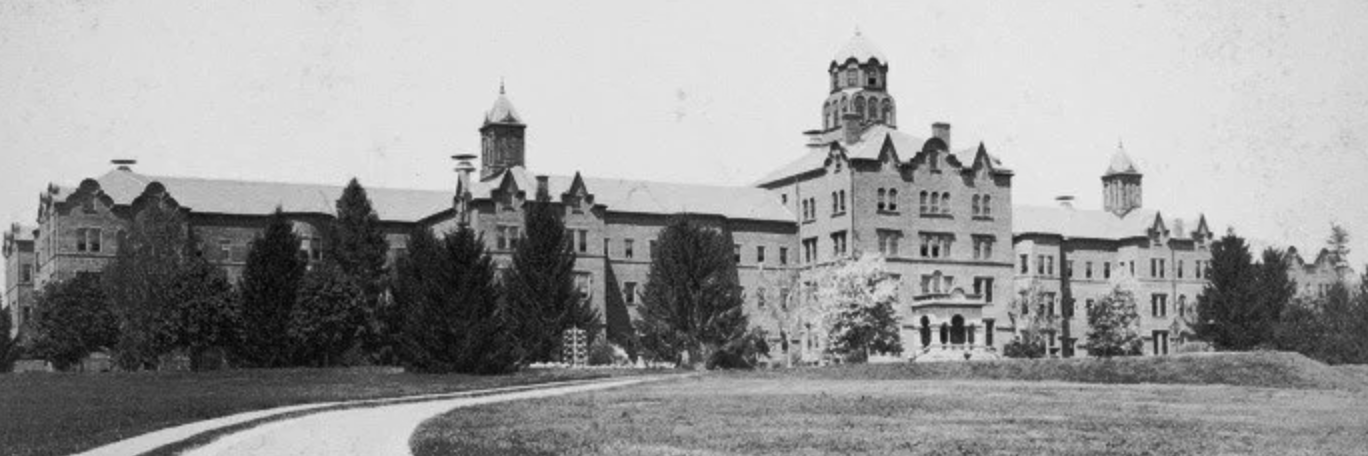Introduction:
Today, signs of the hospital’s existence and the community that resided there have been effectively erased from Northampton’s public memory. The hospital’s campus is being redeveloped into apartment complexes and renamed “Village Hill.” Yet despite developers’ efforts at erasure, the memories of the 65,000 people who once lived within the hospital need to be recognized. In spite of the horrific conditions, for many of the people admitted, the hospital served as their home and community. It is important to bear witness to their lived experiences and their acts of resistance against inhumane treatment, as well as recognize why they were forcibly institutionalized, and critically analyze the history of forced psychiatric treatment within the U.S.
As developers continue to transform the former hospital grounds, there have been several efforts to memorialize the state hospital. This site will highlight two of these efforts. While these monuments have largely been successful in preserving the hospital’s architecture and history of transformation, there is still work to do to preserve the experiences of the hospital’s residents.
The State Hospital: In Memoriam:
On the3 17th and 18th of November, 2000, a series of memorial events took place in Northampton focusing on the history of Northampton State Hospital. The two-day event titled The State Hospital: In Memoriam included an academic symposium, an open forum with former patients, and three art exhibitions. The event was sponsored by the Massachusetts Mental Health Center (MMHC) Continuing Education Program and offered continuing education credits to psychologists and nurses in attendance.
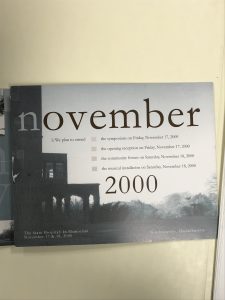
The academic symposium took place on the first day of the series at Smith College. It featured the research and experiences of psychiatrists, mental health professionals, and academics from around the United States. Unfortunately, little information about the panel and what was discussed was preserved.
The following day, an open forum occurred in Smith College’s Sage Hall. During this forum, former NSH patients were invited to share stories of their experiences inside the hospital. Patients were not prompted with specific questions and were encouraged to speak freely and frankly. Below are sections of dialog from 3 former hospital patients whose interviews were recorded on video. Their stories tell of both the horrors and benefits tied into the complex history of psychiatric treatment.
“Sure there were times where I would be totally psychotic because I wouldn’t take my meds and I had to be put in restraints, but I figured that was all part of the scheme of things. It did me a whole heck of a lot of good. I mean, I am clean and sober 6 years now. “
“One night I got put in restraints because I had an epileptic seizure. And then they had a male attendant do 24 hour guard to me which was against the law. We got a little warning and next thing I knew, he raped me. Next day they took what happened and it was my word against his.”
“I’ve been in the hospital off and on since 1975. I had been institutionalized several times. And to me it was just like a hospital. It was a revolving door. Each visit makes you feel like a zombie. It’s no fun not seeing your family. It’s no fun not having your freedom. I now have my learners permit. I’m on the verge of getting my check back in my name. I have a lovely wife. I’ve been married 11 ½ years. But you know what, I love her very much and I hope she understands that.”
The event closed with a sound installation at the site of the hospital’s old main building. The art installation was designed by visual artist Anna Schuleit Haber and intended to reference the events of the laying of the hospital cornerstone in 1856. Attendants of the forum walked in procession from Smith College to the former hospital grounds– a ceremony mimicking the original path of the Cornerstone laying ceremony during the 19th-century.
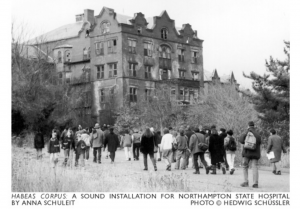
At noon, bells from surrounding churches rang in unison to invoke a communal moment of silence, followed by “Habeas Corpus,” a sound installation in which J.S. Bach’s Magnificat, played on installed speakers from inside the empty old main building. The memorial series closed after the end of the 28-minute sound installation. While the sound installation and patient forum provided a mourning community the opportunity to part with the physical grounds of the hospital before demolition began in 2002; unfortunately, the symposium and related press was predominately focused on the artwork of Anna Schuleit Harber rather than the experiences of the NSH patients. [1]
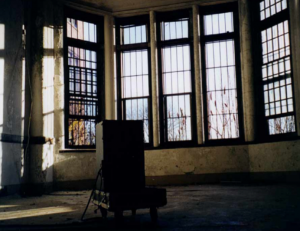
Video of the patient forum and sound installation (Courtesy of Anna Schuleit Haber)
Northampton State Hospital Burial Ground & Hospital Hill Walking Tour:
The second memorial begins with the bench at the Northampton State Hospital Burial Ground. The original bench was placed as a temporary marker in 1959 in memory of the 181 unmarked burials for patients who died while admitted in the hospital. Northampton records indicated that another 400 patients were buried here or at other sites in Northampton. Who the patients were and the cause of their cause of deaths remains unknown.

In the mid-2000s the original bench and marker were in disrepair and needed replacing. This past fall, The Northampton Historical Commission raised the funds and dedicated a new bench and historical marker in memory of these individuals. The dedication ceremony included: Northampton Mayor David Narkewicz; Pat Goggins, whose father William J. Goggins, Jr., a business manager at the State Hospital during Pat’s childhood, erected the first memorial bench on this site; Rebecca Macaulay, a former NSH patient and employee and patients’ rights advocate; and Tom Riddell, professor emeritus at Smith College, where he taught “The Evolution and Transformation of the Northampton State Hospital,” a seminar for first-year students.
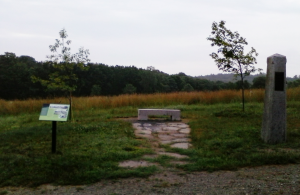
This project does significant work by increasing the visibility of the former NSH grounds and recognizing the graves of former patients. While the dedication ceremony included the experiences of former patients, the majority of information on the current memorial plaque is predominately focused on the history of the bench memorialization efforts rather than the history of the hospital and former patients. It’s important to note that out of the 100 words on this marker, only one sentence recognizes the individuals buried there.
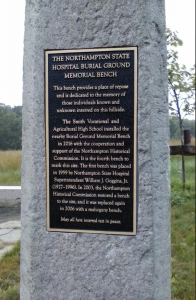
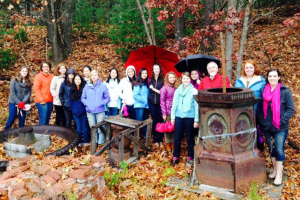
The newly-installed stone bench, an obelisk with a brass plaque inscribed with words dedicated to those interred on the hillside, and an informational sign are the first of many planned as part of a Northampton State Hospital Walking Tour. The Walking Tour was initially proposed by Tom Riddell’s 2014 First-year seminar class. The Tour of Hospital Hill was designed to provide information on the land and buildings formerly owned by the Northampton State Hospital as well as bear witness to the experiences of those who lived and worked there. The tour shows nine historic sites that were preserved in demolition and redevelopment. Through photographs, letters and oral histories, the hospital markers and memorial park will preserve the hospitals complex existence. The students’ research focusing on the history of the Northampton State Hospital and details of redevelopment are also provided on the accompanying website.
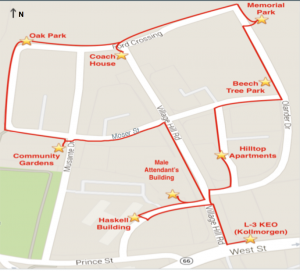
After completing the course, the students shifted responsibility for the project to The Northampton Historical Commission. In Spring 2016, Mass. Humanities Board and Smith College each pledged donations to help fund the project’s development. As of Spring 2018, the Planning Committee for the Walking Tour is currently fundraising and developing plaque content.
Looking forward, as these memorials continue to develop and take shape, it’s important to recognize that Northampton State Hospital’s history is not an isolated case. There were hundreds of psychiatric hospitals in the U.S. housing similar horrific conditions. And some facilities are still in operation today, forcing different types of psychiatric treatment. In order to make change and continue improving mental-health care and the conditions of these facilities, we have to bear witness to the past experiences of those institutionalized.
References:
[1] Pamphlet titled “The State Hospital: In Memorium,” November 2000, Box 3, Folder 1, Northampton and Local History, Smith College Archives.
